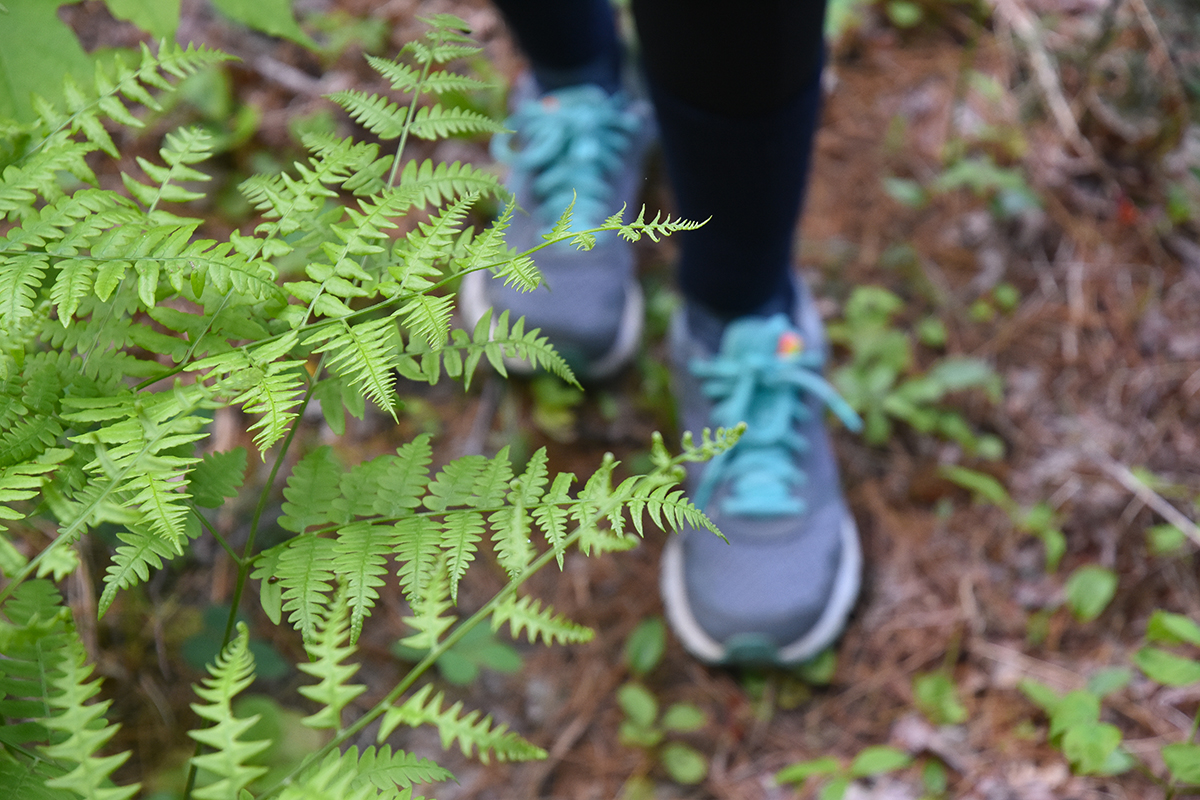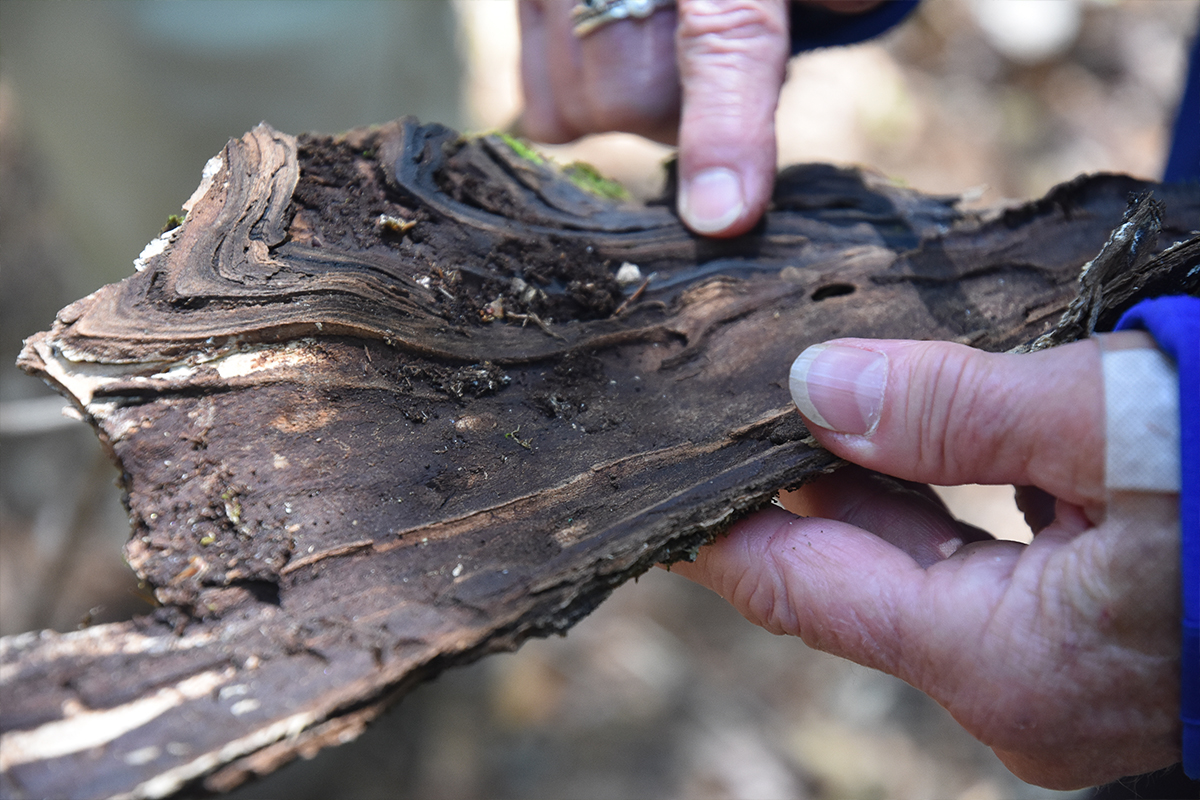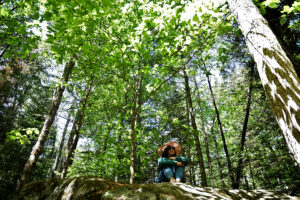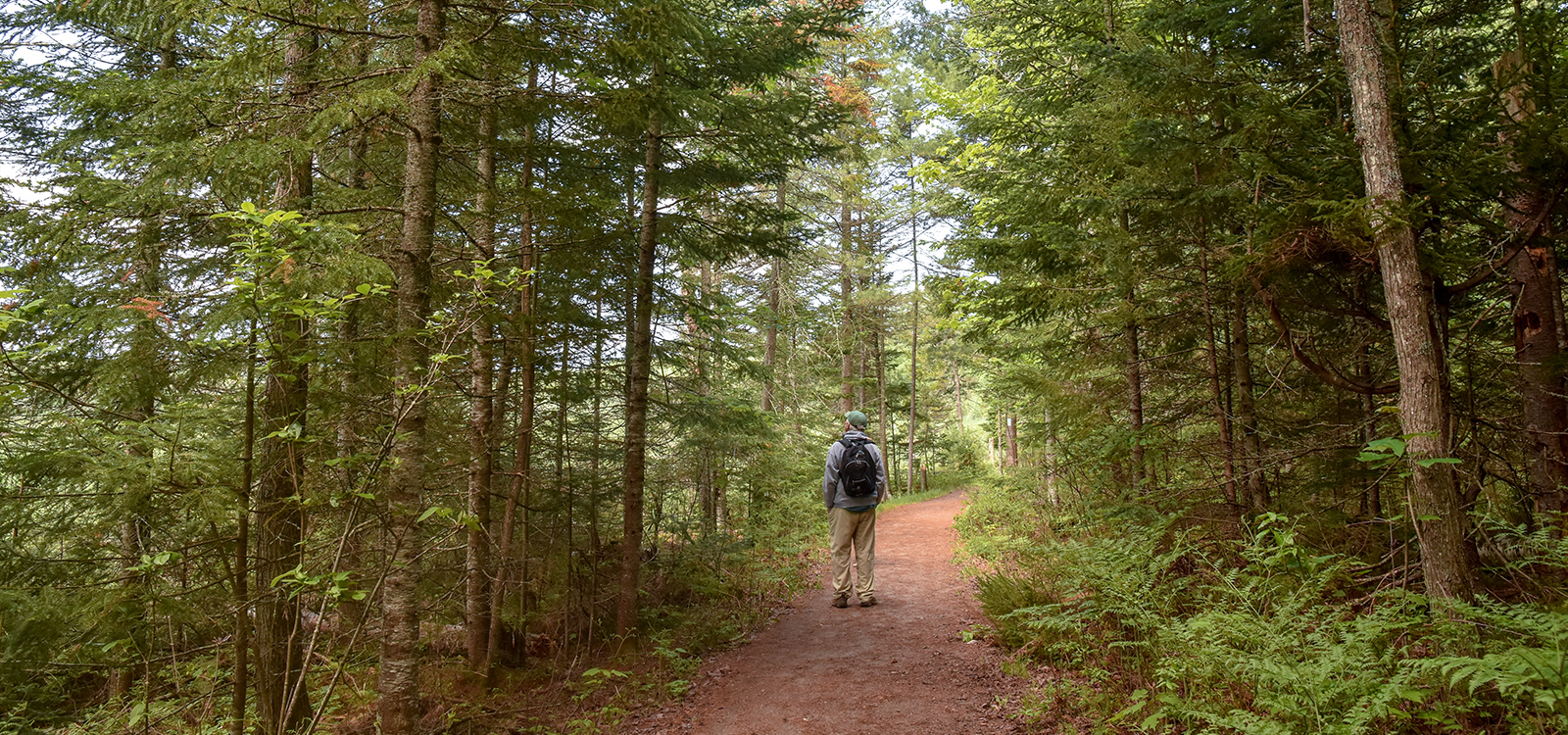How Forest Bathing Cleansed Me Of Stress
I gather at the trailhead with four others — an older couple and their daughter in her mid-20s, and a college student from Cuba. Frogs croak in the pond beside us, and a duck, startled by our arrival, propels itself out of the water and flies away, quacking. We arrive to experience something called “forest bathing,” a simple practice that seeks to treat the mind and body by immersion in nature. The practice originated in Japan, where it’s known as Shinrin-Yoku. Developed in the 1980s as a way to combat high stress levels, Shinrin-Yoku became a part of the country’s healthcare and wellness plan and is even covered by insurance there.
“Our organization is looking at it as more of a connectedness with nature, more than just ‘this will make you feel better,’ but as a way to make people say, ‘I need my time in the woods.’”
“The forest environment has long been enjoyed in Japan for its quiet atmosphere, beautiful scenery, calm climate, and clean, fresh air in forests,” says Qing Li, chairman and founding member of the Japanese Society for Forest Medicine who practices at Tokyo’s Nippon Medical School. Li points out that Shinrin-Yoku has transitioned from an elemental piece of Japanese culture to a science, which is the new medical science called Forest Medicine.

“They actually have studies that show that people feel better mentally, their blood pressure goes down, all the stress indicators are better after they’ve been out in the woods,” Clifford says. Photo by Marita Pérez Díaz.
The Japanese approach of wellness through time spent in the woods spread, and organizations developed to train guides and support forest programs. The Association of Nature and Forest Therapy Guides and Programs (ANFT) was founded in 2012 by Amos Clifford, one of the leading voices of Japanese-inspired forest therapy in the United States. Based in Santa Rosa, Calif., ANFT serves as a worldwide resource for finding a forest-bathing guide and seeks to incorporate forest therapy into health and wellness systems. Visitors can find forest-therapy guides almost anywhere in the world by clicking on an interactive map that shows all of the guides. Clifford says the activity can improve mood and concentration abilities. In addition, forest bathing helps improve blood pressure, pulse rate, and can lower bodily cortisol concentrations, a hormone that indicates stress, according to a study by the Japanese medical journal, Environmental Health and Preventive Medicine. “It’s just this huge consensus that going for gentle, slow walks in the woods creates some very favorable physiological conditions,” says Clifford.
But when the activity began to attract participants beyond Japan, it also began to enlist enthusiasts for reasons beyond those documented health benefits. Lisa Mediano, an ANFT-certified forest-bathing guide who practices in Boston and Medford, Mass., says she thinks it’s because Americans respond less to health directives and long for excuses to be in nature. “Our organization is looking at it as more of a connectedness with nature, more than just ‘This will make you feel better,’ but as a way to make people say, ‘I need my time in the woods,’” Mediano says.
I count myself in that category. Practitioners describe forest bathing as a way to pique the childlike curiosity within us all. The 7-year-old me loved running down trails, climbing trees, and splashing in brooks. I feel most like myself when I’m in nature, and though they weren’t always available to me growing up, wild things fascinated me. This appreciation for the environment grew into an urgent need to protect it. I majored in environmental biology in college and spent years sampling soils and tracking wildlife populations. But it’s been a while since I’d taken the time to be in nature, with no purpose besides my own fulfillment. I’ve almost forgotten what it feels like to be outside and surrounded by an environment untouched by humans. I also worry my brain lacks the ability to enjoy this experience. Lately I’ve noticed I create contentment by being busy, and restlessness wiggles in when I run out of to-do items to tackle.
But our forest bathing guide Suzanne Weirich inspires a confidence in me that settles my mind and allows me to focus on the nature that surrounds me. A petite, sweet-voiced woman, she gives off a nurturing vibe. She wears a bright blue shirt that is as cheery as she is, yoga pants, and a floppy sun hat. She begins to lead us down the trail. I hope my prior education won’t distract me from the experience. Resisting the urge to run ahead because I see a bird that looked like the endangered peregrine falcon isn’t exactly conducive to a relaxing walk in the woods. Soon, she stops and asks us to close our eyes, inviting us to take in the forest where we stand through four of our senses.
“The forest is the therapist, and the guide is opening the door and providing the structure of the experience.”
At first, my restlessness starts to kick in. My thoughts travel to the equipment in my bag, an itch I hope isn’t a tick, and the sudden awareness that I’m sharing this intimate experience with unfamiliar people. My distraction persists. Then Weirich’s calm and gentle voice enters my thoughts. She begins to guide us through the sensory activity, or what’s called an invitation in forest-bathing circles. I feel the relaxation wash over me, and my thoughts evaporate. I forget about the equipment, the deadlines, the strangers around me, the itch. Gratitude begins to replace those thoughts. I feel grateful for the sunshine warming my face, the flora and fauna that make this majestic preserve their home, the sounds of the forest — an opportunity to just be.
Soon enough, she asks us to rotate 60 degrees where we stand, open our eyes, and look at our surroundings as if we’re seeing them for the first time. I slowly come back to reality after melting into my atmosphere. My eyes fall on a wooden bench shaded by a maple tree, and I think about how many people must have rested there and taken in this vista — a marsh teeming with the sounds of wildlife, dragonflies dancing around flowers, tall trees swaying gracefully in the gentle breeze. Weirich, who was an elementary school teacher before she became a forest-bathing guide, says she remembers how she longed to return to nature after living and working in a city. Forest bathing attracted her because it provided an opportunity to make the experience what you wanted it to be — as opposed to the standard procedure of typical guided walks that tell participants what to observe and where to direct their attention. “That’s what led me to nature and forest therapy. I read about it online and I said, ‘How can I guide people outdoors, but let it be their own experience?’” she says.

On our walk, Weirich encouraged us to view nature as art and relate this to the way we were feeling. A participant said this piece of bark reminded them of the curves of a river, reminiscent of life’s twists and turns. Photo by Marita Pérez Díaz.
Deborah Denome, an ANFT-certified guide in Naples, N.Y., agrees. Denome, who worked on a farm and practiced horticultural therapy, became a guide because she says she wanted a way to enjoy being outdoors in a non-intensive way after a back injury. “The forest is the therapist, and the guide is opening the door and providing the structure of the experience,” she says.
To be certified, a guide must first go through a week-long, intensive training in various areas. This training includes being guided by mentors and learning how to tailor each invitation to make them as inclusive as possible to people of all different physical abilities and sensitivities. After that, prospective guides go through a six-month practicum in their home area where, guided by a mentor, they take people out on walks and investigate different plants to use for the ending tea ceremony.

In our last moments forest bathing, we sat silently for 20 minutes in any spot we felt drawn to. No matter if we were up on a sun-soaked rock or exploring a corner of the woods away from the others, we all felt connected to our surroundings. Photo by Marita Pérez Díaz.
We end our walk — a mile-long loop that includes stops at a brook and an invitation to sit quietly — with tea steeped with balsam fir needles. We also gather a final council — a session at the end of each invitation where we all share our experiences with each other. One of the forest bathers, the native Spanish speaker, struggles to express herself in English. Weirich gently asks her to speak in Spanish, and then the words flow out of her mouth as smoothly as the waters of the brook nearby. This prompts another participant to express herself in her native Indonesian. As we sit with each other, drinking tea, laughing, sharing our stories, I feel the presence of the gratitude and the joy shared by the group, just as Weirich predicted earlier when speaking about her experience guiding forest bathers. “We get tears, we get joy, we get all kinds of responses,” Weirich says. “It hits everybody in the heart; it’s very transformational.”
The group walks toward a pavillion at the visitor’s center, where the experience began. As the rest of the crew parts ways, I hang back. I walk over to the brook and sit on a rock for a few blissful, sun-soaked minutes, breathing in the forest air. I begin to notice something different in my breathing. When stressed, I forget to take whole, deep breaths. But in this moment, I inhale with big gulps of pine-scented air and watch as my chest falls. I feel calm, poised. I decide to let my surroundings drive my narrative for a little bit and focus on the creek’s gurgle. A loon’s call breaks my trance. I see a red squirrel scurry in front of me and scale a tree, its tail twitching frantically. I gather my things and begin to walk toward the parking lot. I’m reminded of the resiliency of nature and imagine what this environment must have looked like millions of years ago — glaciers creeping over the landscape and then forming ponds and wetlands with prehistoric variations of red squirrels skittering around and giant ancient moose with huge, branching antlers lumbering around the forest. I take this with me, and as I pull out of the parking lot, I roll down my windows, inviting the forest air to swirl around my face, hair, and join me on the drive home.
Banner photo by Marita Pérez Díaz.
.




